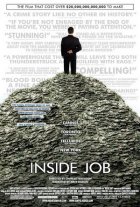
Inside Job Page #5
01:
14:45.00 In 1982, the Reagan administration deregulated savings and loancompanies, allowing them to make risky investments with their depositors' money. By
the end of the decade, hundreds of savings and loan companies had failed. This crisis
cost taxpayers 124 billion dollars, and cost many people their life savings.
TOM BROKAW:
It may be the biggest bank heist in our history.NARRATOR:
Thousands of savings and loan executives went to jail for looting theircompanies. One of the most extreme cases was Charles Keating.
01:
15:17.28MAN:
Mr. Keating, you got a word?NARRATOR:
In 1985, when federal regulators began investigating him, Keating hiredan economist named Alan Greenspan. In this letter to regulators, Greenspan praised
Keating's sound business plans and expertise; and said he saw no risk in allowing
Keating to invest his customers' money. Keating reportedly paid Greenspan 40,000
dollars.
01:
15:45.01 Charles Keating went to prison shortly afterwards. As for Alan Greenspan,President Reagan appointed him chairman of America's central bank, the Federal
Reserve. Greenspan was reappointed by presidents Clinton and George W. Bush.
01:
16:01.00 During the Clinton administration, deregulation continued under Greenspanand Treasury secretaries Robert Rubin — the former CEO of the investment bank
Goldman Sachs — and Larry Summers, a Harvard economics professor.
01:
16:15.26NOURIEL ROUBINI:
The financial sector, Wall Street being powerful; having lobbies,having lots of money; step by step, uh, captured the political system; you know, both on
the Democratic and the Republican side.
01:
16:28.00NARRATOR:
By the late 1990s, the financial sector had consolidated into a few giganticfirms, each of them so large that their failure could threaten the whole system; and the
Clinton administration helped them grow even larger.
Inside Job transcript – Sony Pictures – September 2010
15
In 1998, Citicorp and Travelers merged, to form Citigroup, the largest financial services
company in the world. The merger violated the Glass-Steagall Act, a law passed after
the Great Depression, which prevented banks with consumer deposits from engaging in
risky investment banking activities.
01:
17:02.00{ROBERT GNAIZDA
FORMER DIRECTOR:
GREENLINING INSTITUTE}
ROBERT GNAIZDA:
It was illegal to acquire Travelers. Greenspan said nothing. TheFederal Reserve gave 'em an exemption for a year; and then they got the law passed.
NARRATOR:
In 1999, at the urging of Summers and Rubin, Congress passed theGramm-Leach-Bliley Act, known to some as the Citigroup Relief Act. It overturned
Translation
Translate and read this script in other languages:
Select another language:
- - Select -
- 简体中文 (Chinese - Simplified)
- 繁體中文 (Chinese - Traditional)
- Español (Spanish)
- Esperanto (Esperanto)
- 日本語 (Japanese)
- Português (Portuguese)
- Deutsch (German)
- العربية (Arabic)
- Français (French)
- Русский (Russian)
- ಕನ್ನಡ (Kannada)
- 한국어 (Korean)
- עברית (Hebrew)
- Gaeilge (Irish)
- Українська (Ukrainian)
- اردو (Urdu)
- Magyar (Hungarian)
- मानक हिन्दी (Hindi)
- Indonesia (Indonesian)
- Italiano (Italian)
- தமிழ் (Tamil)
- Türkçe (Turkish)
- తెలుగు (Telugu)
- ภาษาไทย (Thai)
- Tiếng Việt (Vietnamese)
- Čeština (Czech)
- Polski (Polish)
- Bahasa Indonesia (Indonesian)
- Românește (Romanian)
- Nederlands (Dutch)
- Ελληνικά (Greek)
- Latinum (Latin)
- Svenska (Swedish)
- Dansk (Danish)
- Suomi (Finnish)
- فارسی (Persian)
- ייִדיש (Yiddish)
- հայերեն (Armenian)
- Norsk (Norwegian)
- English (English)
Citation
Use the citation below to add this screenplay to your bibliography:
Style:MLAChicagoAPA
"Inside Job" Scripts.com. STANDS4 LLC, 2024. Web. 5 May 2024. <https://www.scripts.com/script/inside_job_42>.



Discuss this script with the community:
Report Comment
We're doing our best to make sure our content is useful, accurate and safe.
If by any chance you spot an inappropriate comment while navigating through our website please use this form to let us know, and we'll take care of it shortly.
Attachment
You need to be logged in to favorite.
Log In